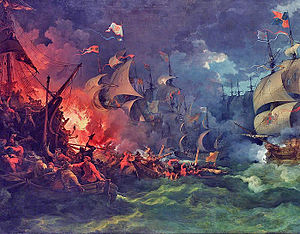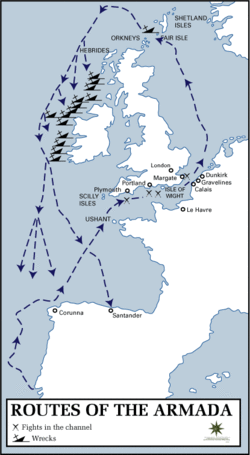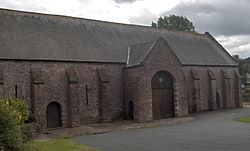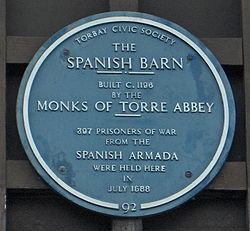
Spanish Armada
Background Information
This Schools selection was originally chosen by SOS Children for schools in the developing world without internet access. It is available as a intranet download. SOS mothers each look after a a family of sponsored children.
| Battle of Gravelines | |||||||
|---|---|---|---|---|---|---|---|
| Part of the Anglo-Spanish War | |||||||
 Defeat of the Spanish Armada, 1588- 08-08 by Philippe-Jacques de Loutherbourg, painted in 1797, depicts the battle of Gravelines. |
|||||||
|
|||||||
| Belligerents | |||||||
| Commanders and leaders | |||||||
| Elizabeth I of England Charles Howard Francis Drake |
Philip II of Spain Duke of Medina Sidonia |
||||||
| Strength | |||||||
| 34 warships 163 armed merchant vessels 30 Dutch flyboats |
22 galleons 108 armed merchant vessels |
||||||
| Casualties and losses | |||||||
| 50–100 dead ~400 wounded 6,000-8,000 died from disease |
600 dead, 800 wounded, 397 captured, 62 ships 15,000-20,000 Soldiers and Sailors dead |
||||||
|
|||||
The Spanish Armada (Spanish: Grande y Felicísima Armada "Great and Most Fortunate Navy" or Armada Invencible, "Invincible Navy") was the Spanish fleet that sailed against England under the command of the Duke of Medina Sidonia in 1588, leading to the Norris-Drake Expedition or English Armada of 1589.
King Philip II of Spain had been king consort of England until the death, in 1558, of his wife, Queen Mary I of England, and he took exception to the policies pursued by her successor, his sister-in-law Elizabeth I. The aim of his expedition was to invade and conquer England, thereby suppressing support for the United Provinces – that part of the Spanish Netherlands in possession of the Dutch rebels – and cutting off attacks by the English against Spanish possessions in the New World and against the Atlantic treasure fleets. The king was supported by Pope Sixtus V, who treated the invasion as a crusade, with the promise of a further subsidy should the Armada make land.
The Armada's appointed commander was the highly experienced Álvaro de Bazán, but he died in February 1588, and Medina Sidonia took his place. The fleet set out with 22 warships of the Spanish Royal Navy and 108 converted merchant vessels, with the intention of sailing through the English Channel to anchor off the coast of Flanders, where the Duke of Parma's army of tercios would stand ready for an invasion of the south-east of England.
The Armada achieved its first goal and anchored outside Gravelines, at the coastal border area between France and the Spanish Netherlands. While awaiting communications from Parma's army, it was driven from its anchorage by an English fire ship attack, and in the ensuing battle at Gravelines the Spanish were forced to abandon their rendezvous with Parma's army.
The Armada managed to regroup and withdraw north, with the English fleet harrying it for some distance up the east coast of England. A return voyage to Spain was plotted, and the fleet sailed into the Atlantic, past Ireland. But severe storms disrupted the fleet's course, and more than 24 vessels were wrecked on the north and western coasts of Ireland, with the survivors having to seek refuge in Scotland. Of the fleet's initial complement, about 50 vessels failed to make it back to Spain.
The expedition was the largest engagement of the undeclared Anglo–Spanish War ( 1585– 1604).
The planned invasion of England
Prior to the undertaking, Pope Sixtus V allowed Philip II of Spain to collect crusade taxes and granted his men indulgences. The blessing of the Armada's banner on 25 April 1588 was similar to the ceremony used prior to the Battle of Lepanto in 1571. On 28 May 1588 the Armada set sail from Lisbon, headed for the English Channel. The fleet was composed of around 130 ships, 8,000 sailors and 18,000 soldiers, and bore 1,500 brass guns and 1,000 iron guns; it took two days for the last vessel to leave port. It contained 28 real warships: twenty galleons, four galleys and four galleasses; the remainder of the heavy vessels mainly consisted of armed carracks and hulks; also 34 light ships were present. In the Spanish Netherlands an army of 30,000 men awaited its arrival, the plan being to use the fleet to convey the continental army on barges to a place near London; the Spanish admirals probably intended to first land the ship-bound force in the west of England, though this had been explicitly forbidden by Philip. All told, it was envisaged to muster 55,000 men, a huge army for that time. On the day of the fleet's departure, Elizabeth's ambassador in the Netherlands, Dr Valentine Dale, met Parma's representatives to begin peace negotiations. On July 17 negotiations were abandoned, and the English fleet stood prepared – though ill-supplied – at Plymouth, awaiting news of Spanish movements, after having in vain tried to intercept the Armada in the Bay of Biscay.
The Armada was delayed by bad weather, forcing the four galleys and one galleon to leave the fleet, and was not sighted in England until July 19, when it appeared off St Michael's Mount in Cornwall. The news was, albeit slowly, conveyed to London by a system of beacons that had been constructed along the length of the south coast of England. During the evening the English fleet was trapped in Plymouth harbour by the incoming tide. The Spanish convened a council of war, where it was proposed to ride into the harbour on the tide and incapacitate the English ships at anchor and from there to attack England; but Medina Sidonia declined this advice, and that same night 55 ships of the English fleet set out in pursuit from Plymouth under the command of Lord Howard of Effingham, with as Vice Admiral Sir Francis Drake. Howard gave Drake, being the more experienced naval commander, some control during the campaign. Rear Admiral was Sir John Hawkins.
The next night, in order to execute their "line ahead" attack, the English tacked upwind of the Armada, thus gaining the weather gage, a significant advantage. Over the next week there followed two inconclusive engagements, at Eddystone and the Isle of Portland. Two Spanish ships, the carrack Rosario and the galleon San Salvador, were abandoned after having been severely damaged by accidents; they were taken by the English who thereby captured a large supply of much-needed gunpowder. At the Isle of Wight the Armada had the opportunity to create a temporary base in protected waters and wait for word from Parma's army. In a full-scale attack, the English fleet broke into four groups – Martin Frobisher now also being given command over a squadron – with Drake coming in with a large force from the south. At the critical moment Medina Sidonia sent reinforcements south and ordered the Armada back in to open sea to avoid sandbanks. There were no secure harbours nearby, so the Armada was compelled to make for Calais, without regard to the readiness of Parma's army.
On July 27, the Armada anchored off Calais in a tightly packed defensive crescent formation, not far from Dunkirk, where Parma's army, reduced by diseases to 16,000, was expected to be waiting, ready to join the fleet in barges sent from ports along the Flemish coast. Communications had proven to be far more difficult than anticipated, and it only now became clear that this army had yet to be equipped with sufficient transport or assembled in port, a process which would take at least six days, while Medina Sidonia waited at anchor; and that Dunkirk was blockaded by a Dutch fleet of thirty flyboats under Lieutenant-Admiral Justin of Nassau. Parma desired that the Armada send its light petaches to drive away the Dutch, but Medina Sidonia could not do this because he feared to need these ships himself for his protection. There was no deep-water port where the fleet might shelter – always acknowledged as a major difficulty for the expedition – and the Spanish found themselves vulnerable as night drew on. At midnight on July 28 the English set alight eight fireships, sacrificing regular warships by filling them with pitch, brimstone, some gunpowder, and tar, and cast them downwind among the closely-anchored vessels of the Armada. The Spanish feared that these uncommonly large fireships were ' hellburners', specialised fireships filled with large gunpowder charges, which had been used to deadly effect at the Siege of Antwerp.: two were intercepted and towed away, but the remainder bore down on the fleet. Medina Sidonia's flagship and the principal warships held their positions, but the rest of the fleet cut their cables and scattered in confusion. No Spanish ships were burnt, but the crescent formation had been broken, and the fleet now found itself too far to leeward of Calais in the rising south-westerly wind to recover its position. The English closed in for battle.
The Battle of Gravelines
The small port of Gravelines was then part of Flanders in the Spanish Netherlands, close to the border with France and the closest Spanish territory to England. Medina Sidonia tried to re-form his fleet there, and was reluctant to sail further east owing to the danger from the shoals off Flanders, from which his Dutch enemies had removed the sea-marks.
The English had learned more of the Armada's strengths and weaknesses during the skirmishes in the English Channel, and had concluded it was necessary to close within a hundred metres to penetrate the oak hulls of the Spanish ships. In the first engagements they had spent most of their gunpowder and had after Wight been forced to conserve their heavy shot and powder for a final decisive attack near Gravelines. During all engagements, the Spanish heavy guns proved unwieldy, and their gunners had not been trained to reload – in contrast to their English counterparts, they fired once and then jumped to the rigging to attend to their main task as marines ready to board enemy ships. In fact, evidence from Armada wrecks in Ireland shows that much of the fleet's ammunition was never spent. Their determination to thrash out a victory in hand-to-hand fighting proved a weakness for the Spanish; it had been effective on occasions such as the Battle of Lepanto and at the Battle of Punta Delgada (1582), but the English were aware of this strength and sought to avoid it.
With its superior manoeuvrability, the English fleet provoked Spanish fire while staying out of range. Once the Spanish had lost their heavy shot, the English then closed, firing repeated and damaging broadsides into the enemy ships. This also enabled them to maintain a position to windward so that the heeling Armada hulls were exposed to damage below the water-line.
Five Spanish ships were lost. The galleass San Lorenzo ran aground at Calais and was taken by Howard after murderous fighting, between the crew, the galley slaves, the English and the French who ultimately took possession of the wreck. The galleons San Mateo and San Felipe drifted away in a sinking condition, ran aground on the isle of Walcheren the next day and were taken by the Dutch. One carrack ran aground near Blankenberge, another foundered. Many other Spanish ships were severely damaged, especially the Spanish and Portuguese Atlantic-class galleons who had to bear the brunt of the fighting during the early hours of the battle in desperate individual actions against groups of English ships. The Spanish plan to join with Parma's army had been defeated, and the English had afforded themselves some breathing space. But the Armada's presence in northern waters still posed a great threat to England.
Tilbury speech
On the day after the battle of Gravelines, the wind had backed southerly, enabling Medina Sidonia to move his fleet northward away from the French coast. Although their shot lockers were almost empty, the English pursued in an attempt to prevent the enemy from returning to escort Parma. On August 2 Old Style, August 12 New Style, Howard called a halt to the pursuit in the latitude of the Firth of Forth off Scotland. By that point, the Spanish were suffering from thirst and exhaustion, and the only option left to Medina Sidonia was to chart a course home to Spain, along the most hazardous parts of the Atlantic seaboard.
The threat of invasion from the Netherlands had not yet been discounted, and Robert Dudley, Earl of Leicester maintained a force of 4,000 soldiers at West Tilbury, Essex, to defend the estuary of the River Thames against any incursion up-river towards London.
On August 8 (Old Style), August 18 New Style, Queen Elizabeth went to Tilbury to encourage her forces, and the next day gave to them what is probably her most famous speech:
| “ | My loving people, we have been persuaded by some that we are careful of our safety, to take heed how we commit ourselves to armed multitudes for fear of treachery; but, I do assure you, I do not desire to live to distrust my faithful and loving people. Let tyrants fear, I have always so behaved myself, that under God I have placed my chiefs' strength and safeguard in the loyal hearts and goodwill of my subjects; and, therefore, I am come amongst you as you see at this time, not for my recreation and disport, but being resolved, in the midst and heat of battle, to live or die amongst you all - to lay down for my God, and for my kingdoms, and for my people, my honour and my blood even in the dust. I know I have the body of a weak and feeble woman; but I have the heart and stomach of a king - and of a king of England too, and think foul scorn that Parma or Spain, or any prince of Europe, should dare to invade the borders of my realm; to which, rather than any dishonour should grow by me, I myself will take up arms - I myself will be your general, judge, and rewarded of every one of your virtues in the field. I know already, for your forwardness, you have deserved rewards and crowns, and, we do assure you, on the word of a prince, they shall be duly paid you. For the meantime, my Lieutenant-General Leicester shall be in my stead, than whom never prince commanded a more noble or worthy subject; not doubting but by your obedience to my General, by your concord in the camp, and your valour in the field, we shall shortly have a famous victory over these enemies of my God, of my kingdom and of my people. | ” |
Return to Spain around the British and Irish Isles
The Armada sailed around Scotland and Ireland into the North Atlantic. The ships were beginning to show wear from the long voyage, and some were kept together by having their hulls bundled up with cables. Supplies of food and water ran short, and the cavalry horses were cast overboard into the sea. The intention would have been to keep well to the west of the coast of Scotland and Ireland, in the relative safety of the open sea. However, there being at that time no way of accurately measuring longitude, the Spanish were not aware that the Gulf Stream was carrying them north and east as they tried to move west, and they eventually turned south much further to the east than planned, a devastating navigational error. Off the coasts of Scotland and Ireland the fleet ran into a series of powerful westerly gales, which drove many of the damaged ships further towards the lee shore. Because so many anchors had been abandoned during the escape from the English fireships off Calais, many of the ships were incapable of securing shelter as they reached the coast of Ireland and were driven on to the rocks. The late 1500s, and especially 1588, were marked by unusually strong North Atlantic storms, likely associated with a high accumulation of polar ice off the coast of Greenland, a characteristic phenomenon of the "Little Ice Age." As a result many more ships and sailors were lost to cold and stormy weather than in combat.
Following the gales it is reckoned that 5,000 men died, whether by drowning and starvation or by slaughter at the hands of English forces in Ireland. Reports from passage around Ireland abound with strange accounts of brutality and survival and attest to the qualities of the Spanish seamanship. Some survivors were concealed by Irish people, but few shipwrecked Spanish survived to be taken into Irish service, fewer still to return home. In the end, 67 ships and around 10,000 men survived. Many of the men were near death from disease, as the conditions are very cramped and most of the ships ran out of food and water. Many more died in Spain, or on hospital ships in Spanish harbours, from diseases contracted during the voyage. It was reported that, when Philip II learned of the result of the expedition, he declared, "I sent the Armada against men, not God's winds and waves". Greatly disappointed, he still forgave the Duke of Medina Sidonia.
Consequences
English losses were comparatively few, and none of their ships were sunk. But after the victory, typhus, dysentery and hunger killed many sailors and troops (estimated at 6,000–8,000) as they were discharged without pay: a demoralising dispute occasioned by the government's fiscal shortfalls left many of the English defenders unpaid for months, which was in contrast to the assistance given by the Spanish government to its surviving men.
Although the English fleet was unable to prevent the regrouping of the Armada at the Battle of the Gravelines, requiring it to remain on duty even as thousands of its sailors died, the outcome vindicated the strategy adopted, resulting in a revolution in naval warfare with the promotion of gunnery, which until then had played a supporting role to the tasks of ramming and boarding. The battle of Gravelines is regarded by specialists in military history as reflecting a lasting shift in the naval balance in favour of the English, in part because of the gap in naval technology and armament it confirmed between the two nations, ' which continued into the next century. In the words of Geoffrey Parker, by 1588 'the capital ships of the Elizabethan navy constituted the most powerful battlefleet afloat anywhere in the world.' However, historians now recognize that the Armada campaign did not have lasting consequences upon the naval balance of power. In fact it led to the Spanish Navy undergoing a major reform which helped it to continue dominating European waters well into the next century.
In England, the boost to national pride lasted for years, and Elizabeth's legend persisted and grew well after her death. The repulse of Spanish naval might gave heart to the Protestant cause across Europe, and the belief that God was behind the Protestant cause was shown by the striking of commemorative medals that bore the inscription, He blew with His winds, and they were scattered. There were also more lighthearted medals struck, such as the one with the play on Julius Caesar's words: Venit, Vidit, Fugit (he came, he saw, he fled). The victory was acclaimed by the English as their greatest since Agincourt.
English Armada
However, an attempt to press home the English advantage failed the following year, when a comparable English fleet sailed against Spain in 1589 during the Norris-Drake Expedition or English Armada which met a similar fate, limping home after being held by the Spanish on the coasts of Portugal.
The supply of troops from England to Philip II's enemies in the Netherlands and France continued, but with dwindling success. High seas buccaneering against the Spanish also persisted but with little success. The Anglo-Spanish War thereafter generally favoured Spain. It was not until half a century later that the Dutch interrupted Spanish dominance at sea at the Battle of the Downs in 1639. The strength of Spain's tercios – the dominant fighting unit in European land campaigns for over a century – was likewise broken by the French at the Battle of Rocroi in 1643.
Other meanings
- Spanish Armada ( Armada Española) can also describe the modern navy of Spain, part of the Spanish Armed Forces. The Spanish navy has participated in a number of military engagements, including the dispute over the Isla Perejil. This is not a reference to the Armada above – "armada" simply means "navy" in Spanish.
- In Tennis slang, Spanish Armada is used to refer to the group of highly ranked Spanish players, such as Rafael Nadal, Felix Mantilla, Albert Portas, Juan Carlos Ferrero, Carlos Moyá, and others.



